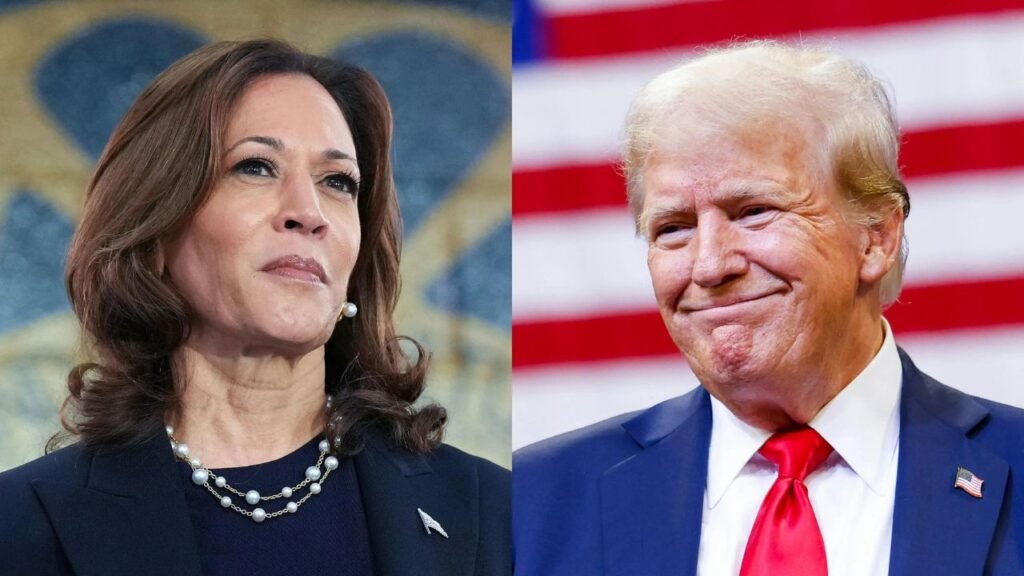Politics
Trump’s Plans Could Increase U.S. Debt While Raising Costs for Most Americans
Published
1 week agoon
By
Rachel
Two recent economic analyses, arguably the most detailed yet on the plans of the Republican nominee, make a strong case that former President Donald J. Trump’s economic policies will only add to the nation’s debt burden and raise costs for the vast majority of Americans in the long run.
The nonpartisan Committee for a Responsible Federal Budget, which advocates for smaller deficits, found that over ten years, the United States debt could balloon by as much as $15 trillion from Mr. Trump’s varied proposals. That is about twice as much as Vice President Kamala Harris’s proposed economic policies.
Moreover, a progressive think tank the Institute on Taxation and Economic Policy concluded that, on average, all the proposed tariffs and tax increases of Mr. Trump would bring a higher tax for every income level except the top 5 percent of American earners.

The two new studies aren’t identical. The tax institute studied the impact of Mr. Trump’s tax and tariff proposals in 2026, while the budget organization studied the cost of both candidates’ spending and tax plans over a ten-year period. But taken together, they illustrate how Mr. Trump’s policies might be costly and regressive in their impact, too-more expensive for the very lowest-income groups.
Much of the proposals Mr. Trump has floated during his campaign-Giving sweeping tariffs on nearly all imports into the United States, exempting certain forms of compensation from taxation among them-read as expansively inclined. Part of a tax code he passed in 2017 that was set to expire after one year is another in a list he wants to extend.
It’s nearly impossible to design a tax plan that raises taxes for most Americans but still raises deficits by hundreds of billions of dollars a year—and that’s what this is, Steve Wamhoff, . program director for government affairs at I.T.E.P
C.R.F.B. warned that there was still considerable uncertainty in its proposals because many of the proposals being put forward by Mr. Trump and Ms. Harris lacked specifics. It provided three spending scenarios for each campaign’s upcoming budget.
On average, Ms. Harris’ plans would add $8 billion over the decade, while Trump’s proposals would be about $15 billion . Harris made $3.5 billion. At the lower end, Ms. Harris’s plan would be “deficit neutral,” adding nothing to the debt by 2035 but Mr. Trump’s plan would add $1.45 trillion.

As per the C.R.F.B. assessment, “both the Democratic and Republican presidential candidates have presented campaign platforms that would, at most, preserve the current state of affairs and, at worst, significantly increase our debt and deficits.” “Neither candidate’s plan would be enough, even in the best-case scenario, to put debt on a downward trajectory and steer America toward a more secure and sustainable fiscal future.”
The Biden budget proposals, according to the Harris campaign, would cut the deficit by $3 trillion, and she has openly said that her ideas will be funded.
The Trump campaign, accusing the Committee for a Responsible Federal Budget of being a lowballer, says the former president’s measures would have a far more substantial impact on the economy.
According to Senior campaign adviser Brian Hughes, “President Trump’s plan will rein in wasteful spending, defeat inflation, reduce the burden of interest costs and ignite economic growth that fuels federal revenue so we can make our economy great again.”
Economists in Washington cannot easily determine whether Mr. Trump’s proposals exempt gratuities and overtime pay from taxes, a move previously warned by experts would invite more people to pay overtime or premiums as part of their pay. The outcome of that could significantly alter the cost of the plans and possibly benefit wealthy Americans who can afford to take advantage of the tax benefits.
Despite acknowledging the uncertainties surrounding that element, the Institute on Taxation and Economic Policy research team believed that Americans would not materially change their behavior as a result of those exclusions. They examined all of Mr. Trump’s tax proposals, which included keeping the tax cuts from 2017, lowering corporate taxes, reinstating the full state and local tax exemption, and eliminating taxes on gratuities, overtime, and Social Security payments. They discovered that while such programs would reduce taxes for all Americans, the wealthiest Americans would gain the most.

However, the projections from the think tank show that Mr. Trump’s intentions to slap broad taxes on imports more than outweigh the savings that many Americans would experience under such cuts. Based on an assumption of a 20 percent tariff on all imports and a 60 percent duty on goods from China, one of the several proposed tariff increases by Mr. Trump, the researchers base their estimate. Another tax that would be expected is the elimination of the green energy incentive tax that President Biden signed into law.
Instead, on average one of the richest Americans would get a 1.2 percent tax cut on his gross income under Mr. Trump’s proposals, but 100 percent of the remaining top 5 percent would see an increase of 1.3 percent. The higher expenses brought by the tariffs would mean losses for every other income group and the lowest 20 percent would be suffering an average loss of 4.8 percent of their income.
According to I.T.E.P., that translates to the wealthiest 1% paying $36,320 less in taxes while the lowest 20% pay $790 more. The average increase for the middle 20 percent of Americans would be $1,530, or 2.1 percent of their income.
Poorer Americans are more susceptible to tariffs, simply because they spend a large percentage of their income on clothing, groceries and other consumer products. Tariffs raise the prices of goods. The costs for rich Americans would also increase because of tariffs, although such added costs would form much smaller percentages of their overall income. Americans with lower incomes pay less in taxes, thus tax cuts do not help them as much as they do those with higher incomes.
Economic studies have consistently shown that import taxes ultimately trickle down to American consumers and businesses, despite Mr. Trump and his campaign’s assertions that their impact will be limited to foreign corporations.
Last month, Mr. Trump said that his tariffs “will be bringing in billions and billions of dollars, which will directly reduce our deficits” at the Economic Club of New York. He said that he will establish a “government efficiency commission” in order to save money.

Despite Ms. Harris’s constant criticism of Mr. Trump’s promises, neither candidate has prioritized deficit reduction in their campaigns. Rather, they have been surpassing each other with fresh expenditure plans and tax reductions. The cost projections are released at a time when the US is already about $36 trillion in debt, with interest payments surpassing government spending on social security and the armed forces.
The big unknown in the proposals of Ms. Harris is how much of Mr. Trump’s 2017 tax reform she would allow to lapse at the end of the next year. Tax increases on individuals making less than $400,000 will not happen, according to the vice president. But how she would address critical tax breaks on gear and research for businesses, or the deductions that enable small businesses, isn’t entirely clear.
Additionally, he did not specify how he would fight state and local tax credits, or SALT. To keep the cost of the whole process from going too high, Mr. Trump’s tax plan capped the SALT tax deduction at $10,000. Senate Majority Leader Chuck Schumer of New York and other Democrats from high-tax blue states have argued that the full deduction should be restored because the cap is scheduled to expire in 2025. That would increase the deficit by more than $1 trillion over a decade and disproportionately benefit the wealthy.

You may like
-


Trump embraces the ‘weave,’ while Harris heads to Fox
-


NBC polling analyst says Kamala Harris’ 5-point advantage in previous poll is ‘gone’
-


New York Rap Legend ‘Ka’ Dies At 52
-


Disregard social media. This is what Harris’ unrealized capital gains tax proposal means for you.
-


Trump Rejects Calls for Another Debate as 880,000 Early Votes Already Cast
-


Harris makes false claim about Trump’s record on manufacturing jobs